by Philip Boxer
What do we need to learn about complex systems? We need to learn how to work in the ‘collaborative’ quadrant, which in turn involves us in having to model structure-determining processes as well as the familiar structure-determined processes.
This is not easy, because it implicates us as modellers – even as systems developers constrained to satisfying a user’s requirement, we are structure-determining in the way we do our work. How are we to give an account of the dynamic effects of those with power over what happens?
Quite a good place to start is with Zachman, who pioneered work on Enterprise Architecture. Why with Zachman? Because Zachman does a good job of modelling Architecture under conditions in which a symmetric relation to demand can be assumed. Thus in the introduction to the Zachman Institute’s Architecture Framework, it is proposed that the Enterprise…
“…must produce the models in order to deliver systems implementations in the short term, and at the same time for the long term, instantiate the Architecture process in order to ensure on-going coherence of system implementations and to build an Enterprise environment conducive to accommodating high rates of change.”
These “models” are models populating the different squares of the Architecture Framework, the underlying presumption being that the work of the Enterprise as a whole must be to ensure the on-going coherence of its Architecture. Why? Because the presumption is that the behaviour of the Enterprise can be structure-determined by this Architecture. But the question I want to address in this blog is what happens to that framework if we need to assume an asymmetric relation to demand.
What happens in the ‘collaborative’ quadrant is that the Enterprise can no longer be assumed to be structure-determined by a superordinate Architecture. This requires that the Zachman framework be modified with some additional rows and columns:

The additional row introduces the collaborative model through which different architectures are brought into relation with each other. And the two additional columns introduce on the left the models of events of which the data column is itself a representation, and on the right the contexts-of-use in relation to which behaviours are generated.
We see now across the top the four ‘colours’ needed to give an account of taking power to the edge. The addition of the ‘red’ WHO/M column situates the relation to demand (see more on this here), and the ‘black’ WHY column is now assumed to include asymmetric assumptions about the bases of competitive advantage.
So what does this tell us about modelling structure-determining processes?
We can now summarise the above modified Zachman in terms of the following four directions of elaboration, which relate back to the N-S-E-W framework for thinking about different forms of governance:

The ‘South’ direction is unchanged, concerning itself with the detailed method of modelling, but the ‘North’ direction is generalised from the governance of the particular Enterprise to the context-of-governance emerging from collaboration between Enterprises. The ‘West’ direction is largely unchanged too, the addition of models of the events emphasising the particular modality of reality within which the models are being built (i.e. what are the forms of knowledge that we are interested in modelling). The greatest change is the ‘East’ direction, which now emphasises the asymmetric nature of the contexts-of-use in relation to which the collaborative behaviours are being constituted.
What does this tell us? In modelling structure-determined processes, we can take the ‘North-South’ axis as a given, and elaborate the ‘East-West’ axis within its terms. But in structure-determining processes, we have to start with the particular ‘East-West’ relations to context-of-use, and then examine the ways in which they are supported and/or restricted by the ‘North-South’ axis: in responding to asymmetric forms of demand, governance shifts from being an a priori to being an a posteriori consequence of the way we want to be able to respond to the particular demand. This is the challenge of taking governance to the edge.